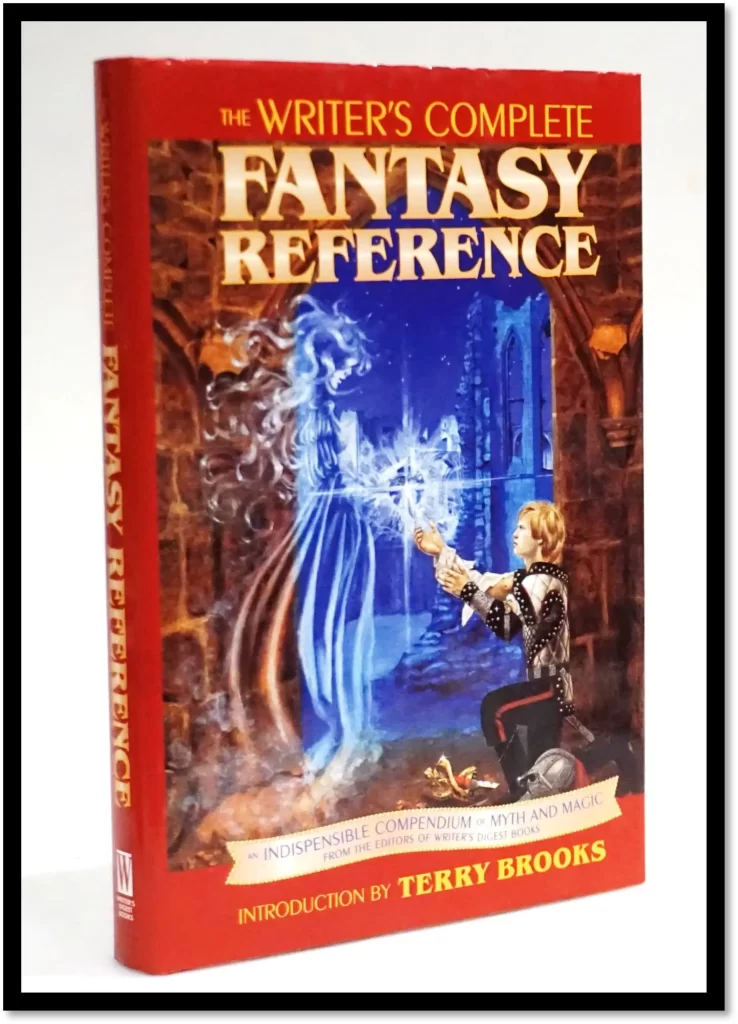
Have you ever wondered what a chimera is…and why it’s three times worst than most monsters? Or do you know what a murder hole is? Or how a castle works? And the best way to attack a castle?
The Writer’s Complete Fantasy Reference: An Indispensable Compendium or Myth and Magic (1998) answers all those questions and many more. In his insightful Introduction, Terry Brooks discusses the methods of writing a fantasy novel. Here’s one of Brooks’s tips:
“I happen to favor rather strongly the practice of outlining a book before trying to write it, and I would recommend it to beginning writers, in particular for two reasons. First, it requires thinking the story through, which eliminates a lot of wasted time chasing bad ideas. Second, it profit a blueprint to which a writer can refer while working a a story over the course of months or even years.” (p. 3)
Another bit of advice Brooks provides comes from his editor (and friend), Lester del Rey: “…new ideas did not come along that often and that when they did, they came in disguise. It was better to take old, established ideas and turn the over and over in your mind until you found a new way to look at them. (p. 3)
My favorite chapter in The Writer’s Complete Fantasy Reference is Michael J. Varhola’s detailed “Anatomy of a Castle.” Varhola’s chapter includes all the facts necessary to write about castles: its fortifications, what castle life is like, and what happens during a siege.
I learned a lot about how to write fantasy fiction from this book. It’s packed with useful information both for the writer and the reader. Are you a fan of fantasy? GRADE: A
TABLE OF CONTENTS:
INTRODUCTION by Terry Brooks — 1
Traditional fantasy cultures / Michael J. Varhola — 4
World cultures / Michael J. Varhola — 31
Magic / Allan Maurer and Renee Wright — 64
Witchcraft and pagan paths / Allan Maurer and Renee Wright — 101
Commerce, trade and law in contemporary fantasy / Sherrilyn Kenyon — 132
Fantasy races / Andrew P. Miller and Daniel Clark — 154
Creatures of myth and legend / Andrew P. Miller and Daniel Clark — 171
Dress and costume / Sherrilyn Kenyon — 191
Arms, armor and armies / Michael J. Varhola — 205
Anatomy of a castle / Michael J. Varhola — 235
INDEX — 263
Old School fan — Howard, CA Smith, Haggard, Lovecraft too (I suppose only UNKNOWN KADATH and HPL’s other Lord Dunsany-imitative stories would fit the Heroic Fantasy template of Brooks’ guide). Even by 1998, I’d lost interest in the newer stuff. Oddly I suppose, I never really latched onto Tolkien.
Fred, I read Michael Moorcock’s Elric fantasy novels–Lancer Books were everywhere back then–and moved on to Howard, Clark Ashton Smith, Lovecraft, and Dunsany like you did. Today’s massive 1000 page fantasy novels by George R. R. Martin and Robert Jordan are slogs for me.
180-page novels by Martin or particularly Jordan would be slogs for some of us. The more space Martin has, the more King-style logorrheic bloat is likely to result.
Todd, George R. R. Martin wrote a classic with “Sandkings” in 1979 but his monetary success came in the form of bloated Fantasy novels.
Even his earlier popular novels such as THE ARMAGEDDON RAG were at best half-good, and such fan-favorite stories as “The Monkey Treatment” were pretty dire. “Sandkings” was decent, as I recall it.
Not so much. I’m more interested in a book like this than reading most fantasy novels.
Jeff, the information provided in THE WRITER’S COMPLETE FANTASY REFERENCE improved my understanding of the genre and its mechanics.
I’m definitely in the old school: William Morris, George MacDonald, Lord Dunsany and Clark Ashton Smith. I enjoyed “The Hobbit” but found the “Rings” trilogy a slog. About the only “modern” writers I care for are Peter S. Beagle and Ursula LeGuin. I’m also a huge fan of Robert Nathan’s lovely, gentle novels and Jack Finney’s time travel stories, both early to mid-twentieth centuy stuff.
I was in high school when people like Brooks and all of the other Tolkienesque writers became the big thing. Even then I had the suspicion they were all just glorified fan fiction writers hopping on the bandwagon. I know George Martin has some legitimate genre credentials from his early days but I will never, ever delve into a doorstoper series and guys like Jordan and Sanderson seem like little more than sausage grinders.On the other hand, looking at the popular fantasy (or romantasy) scene, they are literary giants by comparison. When sorority girls and badly aging soccer moms makeup a genre’s core audience I’d say it’s time to pack it in.
Byron, George R. R. Martin benefited from the TV series of GAME OF THRONES. Brandan Sanderson is a publishing phenomenon with his massive books with their massive sales.
The only fantasies I have involve Zooey Deschanel!
Bob, you are a scamp!
Fantasy? Me?
How many pixels you have? I will note that Terry Brooks hasn’t written anything longer than a few paragraphs that I’ve been moved to read
A sampling:
Conrad Aiken
Joan Aiken
A. A. Attanasio
Peter Beagle
Ambrose Bierce
Algernon Blackwood
Robert Bloch
Jorge Luis Borges
Italo Calvino
Terry Carr
John Collier
Avram Davidson
Grania Davis
Carol Emshwiller
Janet Fox
Damon Knight
William Kotzwinkle
Ursula K. Le Guin
Fritz Leiber
C. L. Moore
E. A. Poe
Kit Reed
Joanna Russ
Margaret St. Clair/”Idris Seabright”
Theodore Sturgeon
Jack Vance
Manly Wade Wellman
Kate Wilhelm–thought I’d added her.
Likewise, Octavia Butler…and how I left out Shirley Jackson, dunno.
Todd, I’ve read every author on your list! Great writers!